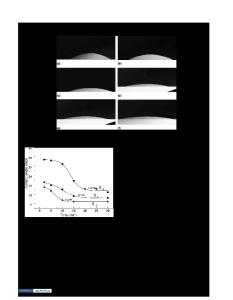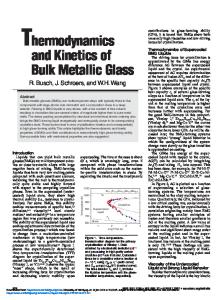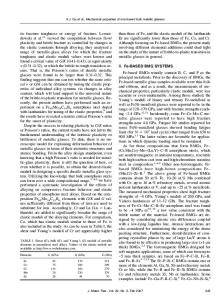High-Strain-Rate Dynamic Mechanical Properties of a W-Reinforced Zr-Based Bulk Metallic Glass Composite
- PDF / 288,603 Bytes
- 6 Pages / 612 x 792 pts (letter) Page_size
- 53 Downloads / 290 Views
0903-Z18-03.1
High-Strain-Rate Dynamic Mechanical Properties of a W-Reinforced Zr-Based Bulk Metallic Glass Composite Morgana Martin1, Naresh N. Thadhani1, Laszlo J. Kecskes2, and Robert J. Dowding2 1 Georgia Institute of Technology, Department of Materials Science and Engineering, 771 Ferst Dr., Atlanta, GA 30332 2 U.S. Army Research Laboratory, Weapons and Materials Research Directorate, AMSRD-ARLWM-MB, Deer Creek Loop, Aberdeen Proving Ground, MD 21005-5069 ABSTRACT The structural/mechanical behavior of zirconium-based (Vitreloy106) bulk metallic glass reinforced with tungsten particles is evaluated using elastic and plastic property measurements via static and dynamic compression tests performed on rod shaped samples. Anvil-on-rod impact tests combined with high-speed digital photography and velocity interferometry are used to obtain qualitative and quantitative information about the transient deformation and failure response of the composites. The deformation and failure mechanisms of recovered impacted specimens are also characterized and correlated with their structure and tungsten phase distribution. The results of these experiments and initial attempts at validating constitutive equations based on homogeneous/inhomogeneous plastic/viscous flow in glassy and glassycrystalline composites will be presented. INTRODUCTION Bulk metallic glass (BMG) matrix composites exhibit unique mechanical properties, including high strength and plasticity. It has been established that the failure of bulk metallic glasses (BMG) does not follow the von Mises criterion [1-7], based on observations that the tensile and compressive failure angles in metallic glasses deviate from the maximum shear stress plane [4, 8-12], and the fracture behavior is dependent on the normal stress acting on the slip plane [1-4, 6, 10-13]. Therefore, the Mohr-Coulomb criterion has been found to be applicable to metallic glasses [2-4, 7, 13, 14], and experimental verification of the applicability of this criterion has been provided by Donovan on tests of Pd40Ni40P20 which showed that the yield strengths in uniaxial and plane strain compression are nearly the same, as expected from the criterion [4]. Vaidyanathan et al. have done indentation studies coupled with simulations to gain further insight into the deformation in bulk metallic glasses [14]. Comparisons made between the experimental data and simulations utilizing elastic theory, von Mises, and Mohr-Coulomb yield criteria showed that the Mohr-Coulomb yield criterion provided the closest approximation to the experimental data. Lund and Schuh [13] compiled a review of the experimental and simulationbased evidence for asymmetric yielding in metallic glasses, concluding that there is indeed a measurable influence of normal stress on plastic yielding of metallic glasses, and that the MohrCoulomb criterion has the appropriate negative trend with pressure. Further, simulations performed in order to gain insight into the yielding of amorphous materials, including Cu-Zr metallic glasses [15] and a glassy
Data Loading...











